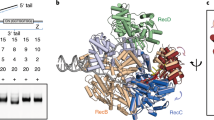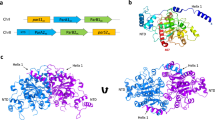Abstract
The KorB protein of the broad-host-range plasmid RP4 acts as a multifunctional regulator of plasmid housekeeping genes, including those responsible for replication, maintenance and conjugation. Additionally, KorB functions as the ParB analog of the plasmid's partitioning system. The protein structure consists of eight helices, two of which belong to a predicted helix-turn-helix motif. Each half-site of the palindromic operator DNA binds one copy of the protein in the major groove. As confirmed by mutagenesis, recognition specificity is based mainly on two side chain interactions outside the helix-turn-helix motif with two bases next to the central base pair of the 13-base pair operator sequence. The surface of the KorB DNA-binding domain mirrors the overall acidity of KorB, whereas DNA binding occurs via a basic interaction surface. We present a model of KorB, including the structure of its dimerization domain, and discuss its interactions with the highly basic ParA homolog IncC.
This is a preview of subscription content, access via your institution
Access options
Subscribe to this journal
Receive 12 print issues and online access
$189.00 per year
only $15.75 per issue
Buy this article
- Purchase on Springer Link
- Instant access to full article PDF
Prices may be subject to local taxes which are calculated during checkout






Similar content being viewed by others
References
Møller-Jensen, J., Jensen, R.B. & Gerdes, K. Plasmid and chromosome segregation in prokaryotes. Trends Microbiol. 8, 313–320 (2000).
Mori, H. et al. Purification and characterization of SopA protein and SopB protein essential for F-plasmid partitioning. J. Biol. Chem. 264, 15535–15541 (1989).
Abeles, A.L., Reaves, L.D. & Austin, S.J. Protein-DNA interactions in regulation of P1 plasmid replication. J. Bacteriol. 171, 43–52 (1989).
Davis, M.A. et al. The P1 ParA protein and its ATPase activity play a direct role in the segregation of plasmid copies to daughter cells. Mol. Microbiol. 21, 1029–1036 (1996).
Motallebi-Veshareh, M., Rouch, D.A. & Thomas, C.M. A family of ATPases involved in active partitioning of diverse bacterial plasmids. Mol. Microbiol. 4, 1455–1463 (1990).
Watanabe, E., Wachi, M., Yamasaki, M. & Nagai, K. ATPase activity of SopA, a protein essential for active partitioning of F-plasmid. Mol. Gen. Genet. 234, 346–352 (1992).
Gerdes, K., Møller-Jensen, J. & Jensen, R.B. Plasmid and chromosome partitioning: surprises from phylogeny. Mol. Microbiol. 37, 455–466 (2000).
van den Ent, F., Møller-Jensen, J., Amos, L.A., Gerdes, K. & Lowe, J. F-actin-like filaments formed by plasmid segregation protein ParM. EMBO J. 21, 6935–6943 (2002).
Møller-Jensen, J., Jensen, R.B., Lowe, J. & Gerdes, K. Prokaryotic DNA segregation by an actin-like filament. EMBO J. 21, 3119–3127 (2002).
Møller-Jensen, J. et al. Bacterial mitosis: ParM of plasmid R1 moves plasmid DNA by an actin-like insertional polymerization mechanism. Mol. Cell 12, 1477–1487 (2003).
Gerdes, K., Møller-Jensen, J., Ebersbach, G., Kruse, T. & Nordström, K. Bacterial mitotic machineries. Cell 116, 359–366 (2004).
Pansegrau, W. et al. Complete nucleotide sequence of Birmingham IncP-α plasmids. Compilation and comparative analysis. J. Mol. Biol. 239, 623–663 (1994).
Adamczyk, M. & Jagura-Burdzy, G. Spread and survival of promiscuous IncP-1 plasmids. Acta Biochim. Pol. 50, 425–453 (2003).
Heinemann, J.A. & Sprague, G.F. Bacterial conjugative plasmids mobilize DNA transfer between bacteria and yeast. Nature 340, 205–209 (1989).
Waters, V.L. Conjugation between bacterial and mammalian cells. Nat. Genet. 29, 375–376 (2001).
Pansegrau, W. & Lanka, E. Conservation of a common 'backbone' in the genetic organization of the IncP plasmids RP4 and R751. Nucleic Acids Res. 15, 2385 (1987).
Thorsted, P.A. et al. Complete sequence of the IncP beta plasmid R751: implications for evolution and organisation of the IncP backbone. J. Mol. Biol. 282, 969–990 (1998).
Bignell, C. & Thomas, C.M. The bacterial ParA-ParB partitioning proteins. J. Biotechnol. 91, 1–34 (2001).
Rosche, T.M., Siddique, A., Larsen, M.H. & Figurski, D.H. Incompatibility protein IncC and global regulator KorB interact in active partition of promiscuous plasmid RK2. J. Bacteriol. 182, 6014–6026 (2000).
Siddique, A. & Figurski, D.H. The active partition gene incC of IncP plasmids is required for stable maintenance in a broad range of hosts. J. Bacteriol. 184, 1788–1793 (2002).
Balzer, D., Ziegelin, G., Pansegrau, W., Kruft, V. & Lanka, E. KorB protein of promiscuous plasmid RP4 recognizes inverted sequence repetitions in regions essential for conjugative plasmid transfer. Nucleic Acids Res. 20, 1851–1858 (1992).
Jagura-Burdzy, G. et al. IncC of broad-host-range plasmid RK2 modulates KorB transcriptional repressor activity in vivo and operator binding in vitro. J. Bacteriol. 181, 2807–2815 (1999).
Williams, D.R., Macartney, D.P. & Thomas, C.M. The partitioning activity of the RK2 central control region requires only incC, korB and KorB-binding site OB3 but other KorB-binding sites form destabilizing complexes in the absence of OB3. Microbiology 144, 3369–3378 (1998).
Macartney, D.P., Williams, D.R., Stafford, T. & Thomas, C.M. Divergence and conservation of the partitioning and global regulation functions in the central control region of the IncP plasmids RK2 and R751. Microbiology 143, 2167–2177 (1997).
Williams, D.R., Motallebi-Veshareh, M. & Thomas, C.M. Multifunctional repressor KorB can block transcription by preventing isomerization of RNA polymerase-promoter complexes. Nucleic Acids Res. 21, 1141–1148 (1993).
Delbrück, H., Ziegelin, G., Lanka, E. & Heinemann, U. An Src homology 3-like domain is responsible for dimerization of the repressor protein KorB encoded by the promiscuous IncP plasmid RP4. J. Biol. Chem. 277, 4191–4198 (2002).
Jagura-Burdzy, G. et al. Repression at a distance by the global regulator KorB of promiscuous IncP plasmids. Mol. Microbiol. 32, 519–532 (1999).
Kostelidou, K. & Thomas, C.M. The hierarchy of KorB binding at its 12 binding sites on the broad-host-range plasmid RK2 and modulation of this binding by IncC1 protein. J. Mol. Biol. 295, 411–422 (2000).
Bechhofer, D.H., Kornacki, J.A., Firshein, W. & Figurski, D.H. Gene control in broad host range plasmid RK2: expression, polypeptide product, and multiple regulatory functions of KorB. Proc. Natl. Acad. Sci. USA 83, 394–398 (1986).
Theophilus, B.D.M. & Thomas, C.M. Nucleotide sequence of the transcriptional repressor gene KorB which plays a key role in regulation of the copy number of broad host range plasmid RK2. Nucleic Acids Res. 15, 7443–7450 (1987).
Kornacki, J.A., Balderes, P.J. & Figurski, D.H. Nucleotide sequence of KorB, a replication control gene of broad host-range plasmid RK2. J. Mol. Biol. 198, 211–222 (1987).
Dostál, L. et al. RP4 repressor protein KorB binds to the major groove of the operator DNA: a Raman study. Biochemistry 42, 14476–14482 (2003).
Lavery, R. & Sklenar, H. Defining the structure of irregular nucleic acids: conventions and principles. J. Biomol. Struct. Dyn. 6, 655–667 (1989).
Kostelidou, K., Jones, A.C. & Thomas, C.M. Conserved C-terminal region of global regulator KorA of broad-host-range plasmid RK2 is required for co-operativity between KorA and a second RK2 global regulator, KorB. J. Mol. Biol. 289, 211–221 (1999).
Holm, L. & Sander, C. Protein structure comparison by alignment of distance matrices. J. Mol. Biol. 233, 123–138 (1993).
Pabo, C.O. & Sauer, R.T. Protein-DNA recognition. Annu. Rev. Biochem. 53, 293–321 (1984).
Brennan, R.G. & Matthews, B.W. Structural basis of DNA-protein recognition. Trends Biochem. Sci. 14, 286–290 (1989).
Harrison, S.C. & Aggarwal, A.K. DNA recognition by proteins with the helix-turn-helix motif. Annu. Rev. Biochem. 59, 933–969 (1990).
Lukaszewicz, M. et al. Functional dissection of the ParB homologue (KorB) from IncP-1 plasmid RK2. Nucleic Acids Res. 30, 1046–1055 (2002).
Surtees, J.A. & Funnell, B.E. P1 ParB domain structure includes two independent multimerization domains. J. Bacteriol. 181, 5898–5908 (1999).
Kim, S.K. & Shim, J. Interaction between F plasmid partition proteins SopA and SopB. Biochem. Biophys. Res. Commun. 263, 113–117 (1999).
Kabsch, W. Automatic processing of rotation diffraction data from crystals of initially unknown symmetry and cell constants. J. Appl. Crystallogr. 26, 795–800 (1993).
Terwilliger, T.C. & Berendzen, J. Automated MAD and MIR structure solution. Acta Crystallogr. D 55, 849–861 (1999).
Terwilliger, T.C. Maximum-likelihood density modification. Acta Crystallogr. D 56, 965–972 (2000).
Jones, T.A., Zou, J.Y., Cowan, S.W. & Kjeldgaard, M. Improved methods for building protein models in electron density maps and the location of errors in these models. Acta Crystallogr. A 47, 110–119 (1991).
Collaborative Computational Project, No. 4. The CCP4 suite: programs for protein crystallography. Acta Crystallogr. D 50, 760–763 (1994).
Perrakis, A., Harkiolaki, M., Wilson, K.S. & Lamzin, V.S. ARP/wARP and molecular replacement. Acta Crystallogr. D 57, 1445–1450 (2001).
Hooft, R.W.W., Vriend, G., Sander, C. & Abola, E.E. Errors in protein structures. Nature 381, 272 (1996).
Laskowski, R.A., MacArthur, M.A., Moss, D.S. & Thornton, J.M. PROCHECK: a program to check the stereochemical quality of protein structures. J. Appl. Crystallogr. 26, 283–291 (1993).
Koradi, R., Billeter, M. & Wüthrich, K. MOLMOL: a program for display and analysis of macromolecular structures. J. Mol. Graphics 14, 51–55 (1996).
Nicholls, A., Sharp, K.A. & Honig, B. Protein folding and association: insights from the interfacial and thermodynamic properties of hydrocarbons. Proteins 11, 281–296 (1993).
Diederichs, K. & Karplus, P.A. Improved R-factors for diffraction data analysis in macromolecular crystallography. Nat. Struct. Biol. 4, 269–275 (1997).
Acknowledgements
We express our gratitude to C. Bernert for assistance with protein purification work to U. Müller and M. Fieber-Erdmann for helpful assistance at the ID14.2 beamline at BESSY, Berlin, to E.-C. Müller and A. Otto for protein sequencing and analyses by mass spectrometry, and to J.J. Müller and K. Fälber for useful discussions and help with crystallographic problems. E.L. and G.Z. thank H. Lehrach for generous support and M. Schlicht for expert assistance. This work was supported by the Deutsche Forschungsgemeinschaft (DFG) and the Fonds der Chemischen Industrie. D.K. acknowledges a DFG fellowship through GRK 80/2.3.
Author information
Authors and Affiliations
Corresponding author
Ethics declarations
Competing interests
The authors declare no competing financial interests.
Supplementary information
Supplementary Fig. 1
Stereo view of the protein-DNA interface. (PDF 131 kb)
Rights and permissions
About this article
Cite this article
Khare, D., Ziegelin, G., Lanka, E. et al. Sequence-specific DNA binding determined by contacts outside the helix-turn-helix motif of the ParB homolog KorB. Nat Struct Mol Biol 11, 656–663 (2004). https://doi.org/10.1038/nsmb773
Received:
Accepted:
Published:
Issue Date:
DOI: https://doi.org/10.1038/nsmb773
This article is cited by
-
Re-visiting protein-centric two-tier classification of existing DNA-protein complexes
BMC Bioinformatics (2012)
-
Structural basis for LEAFY floral switch function and similarity with helix-turn-helix proteins
The EMBO Journal (2008)
-
Segrosome structure revealed by a complex of ParR with centromere DNA
Nature (2007)
-
The bacterial segrosome: a dynamic nucleoprotein machine for DNA trafficking and segregation
Nature Reviews Microbiology (2006)
-
Structures of ParB bound to DNA reveal mechanism of partition complex formation
Nature (2005)



